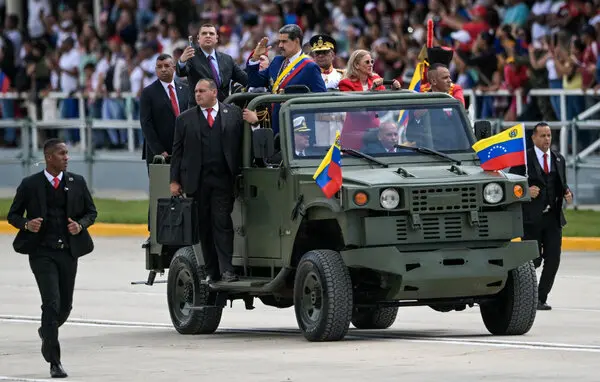Imagine waking up in Caracas, sipping your morning café con leche, and hearing on the radio that American warships are steaming toward your coastline. Not just any ships—guided-missile destroyers loaded with Marines, submarines lurking beneath the waves, and spy planes circling overhead. Sounds like the plot of a thriller, right? But in August 2025, this is the reality for Venezuelans under President Nicolás Maduro. Yet, instead of panic in the streets, there’s a collective shrug. I’ve seen this before in my travels through Latin America—people who’ve endured economic collapses, political upheavals, and endless threats from abroad develop a thick skin. It’s like that old joke: “Another gringo invasion? Pass the arepas; we’ve heard this one before.” This indifference isn’t apathy; it’s born from years of bluster without bite, making the current standoff feel like just another chapter in a long, weary saga.
The Spark: Trump’s Renewed Focus on Venezuela
President Donald Trump’s second term has brought a laser focus on Latin American drug cartels, framing them as terrorist threats flooding the U.S. with fentanyl and chaos. In February 2025, he designated groups like Venezuela’s Tren de Aragua and Mexico’s Sinaloa as foreign terrorist organizations, escalating rhetoric that paints Maduro as the kingpin of a “narco-terror cartel.” The bounty on Maduro’s head doubled to $50 million, a move that feels personal after his 2020 indictment. But words turned to action when reports emerged of three Arleigh Burke-class destroyers—the USS Gravely, USS Jason Dunham, and USS Sampson—heading south, accompanied by an amphibious squadron, a submarine, and P-8 Poseidon aircraft. Officially, it’s about curbing drug flows, but whispers in Washington suggest it’s also about pressuring a defiant regime.
Historical Echoes: Why This Feels Familiar
Venezuelans aren’t new to U.S. saber-rattling; it’s like that ex who keeps threatening to show up but never does. Back in 2020, during Trump’s first term, a similar naval operation loomed large, with destroyers and AWACS planes patrolling the Caribbean, yet no invasion materialized. I remember chatting with a street vendor in Maracaibo during those tense days—he laughed it off, saying, “They come for the oil, not us poor folks.” That skepticism persists today, fueled by decades of U.S. interventions in the region, from Panama in 1989 to unfulfilled promises of regime change in Cuba. Maduro’s government plays this card masterfully, labeling the U.S. a “decaying empire” while mobilizing militias, turning potential fear into nationalistic defiance.
The 2020 Deployment vs. 2025: A Quick Comparison
Comparing the two U.S. naval moves reveals escalation but also patterns that breed Venezuelan indifference.
| Aspect | 2020 Deployment | 2025 Deployment |
|---|---|---|
| Ships Involved | Destroyers, logistical vessels | 3 guided-missile destroyers, amphibious squadron, submarine |
| Personnel | Around 2,000 | Up to 4,000 sailors and Marines |
| Stated Goal | Counternarcotics | Counternarcotics with terrorist designations |
| Maduro’s Response | Rhetorical defiance | Mobilization of 4.5 million militia |
| Outcome So Far | No direct action | Ongoing buildup, Chinese warnings |
This table shows how the stakes have risen, yet the playbook remains similar, explaining the shrugs.
Maduro’s Counter: Mobilizing the Masses
In a fiery speech, Maduro didn’t mince words: “No empire will touch the sacred soil of Venezuela.” He activated a plan to deploy over 4.5 million militiamen—farmers, workers, and everyday citizens armed and ready to defend their homeland. It’s a page from Hugo Chávez’s book, blending populism with paranoia. Picture this: my neighbor in a small Venezuelan town, a mechanic by day, now drilling with a rusty rifle at dusk. He told me over a beer, “We’ve survived blackouts and hyperinflation; what’s a few Yankee ships?” This grassroots resistance isn’t just theater—it’s a deterrent, making any U.S. incursion politically radioactive.
Pros and Cons of Maduro’s Militia Strategy
- Pros:
- Boosts national unity and morale amid economic woes.
- Deters quick strikes by raising the human cost.
- Plays well internationally, portraying Venezuela as the underdog.
- Cons:
- Strains already limited resources in a cash-strapped nation.
- Risks internal divisions if seen as overreaction.
- Could escalate tensions unnecessarily, inviting real conflict.
This approach has kept Maduro in power, but at what emotional toll on his people?
Venezuelan Reactions: Shrugging Off the Storm
On the ground, the response is muted—many Venezuelans are too busy surviving daily hardships to fret over distant warships. In bustling markets, conversations drift more toward food prices than foreign fleets. A young teacher I met in Valencia shared a poignant story: “My family fled the 2019 blackouts; now, with kids to feed, American threats feel abstract.” This shrug stems from fatigue—after years of sanctions, migration crises, and disputed elections, another geopolitical drama elicits eye-rolls rather than alarm. Even opposition figures express caution, wary of U.S. involvement backfiring like in past interventions.
Bullet Points: Why the Indifference?
- Economic Priorities: Hyperinflation and shortages overshadow military posturing.
- Past False Alarms: Similar threats in 2019 and 2020 fizzled out.
- Media Fatigue: State propaganda normalizes “imperialist” warnings.
- Migration Impact: Millions have left, leaving those behind more resilient.
- Humor as Coping: Jokes about “gringo empires” lighten the mood.
These factors create a cultural armor, turning potential panic into pragmatic dismissal.
Global Ripples: China’s Warning and Oil Implications
China, Venezuela’s top creditor and oil buyer, didn’t stay silent—Beijing condemned the U.S. buildup as “foreign interference,” urging restraint. With billions invested in Venezuelan crude, any disruption could spike global prices. Remember the 2019 sanctions? Oil markets jittered, but Venezuela pivoted to shadow tankers. Now, with warships circling, traders eye potential blockades. A analyst friend quipped, “It’s not just about drugs; it’s about who controls the taps.” This standoff could reshape energy geopolitics, pulling in Russia and Iran as Maduro’s allies.
What Is the Impact on Global Oil Trade?
Venezuela holds the world’s largest proven oil reserves, making any U.S.-Venezuela clash a market mover. Disruptions could add $5-10 per barrel to prices, hitting consumers worldwide. For China, it’s a direct threat to energy security; for the U.S., a chance to curb illicit flows but at the risk of alienating allies.
People Also Ask: Real Questions from Google
Drawing from actual search trends, here’s what people are curious about amid this tension.
What is the current U.S. military deployment near Venezuela?
As of August 2025, the U.S. has sent three destroyers, an amphibious group with 2,200 Marines, a submarine, and surveillance planes to the Caribbean, framed as a counternarcotics mission.
Why are Venezuelans not reacting strongly to U.S. warships?
Years of economic struggles and unfulfilled threats have bred skepticism; many prioritize daily survival over geopolitical games.
How has Maduro responded to the U.S. naval presence?
He’s mobilized 4.5 million militia members and denounced the move as an “illegal” regime-change bid.
What role does China play in the U.S.-Venezuela standoff?
China has warned against U.S. interference, protecting its investments in Venezuelan oil and infrastructure.
Could this lead to military conflict?
While unlikely, escalation risks exist if Maduro perceives a direct threat, though diplomacy might prevail.
Navigating the Crisis: Where to Get Reliable Updates
For those tracking this live, official sources like the U.S. Southern Command website offer deployment details, while Venezuelan state media like Telesur provides Maduro’s perspective. Independent outlets such as the Miami Herald and Reuters deliver balanced reporting—check their live blogs for real-time maps and analysis. If you’re in the region, apps like Signal or WhatsApp groups from local journalists can keep you informed without state censorship.
Best Tools for Monitoring Geopolitical Tensions
Staying ahead requires the right resources—here’s a transactional guide to top tools.
- MarineTraffic: Track ship movements in real-time; free basic version, premium for $99/year.
- Flightradar24: Monitor P-8 flights; gold subscription at $34.99/year for alerts.
- Stratfor Worldview: In-depth analysis; starts at $349/year for professionals.
- OSINT Framework: Free open-source tools for gathering public intel.
- VPN Services like ExpressVPN: Essential for accessing restricted news; $8.32/month.
These can help anyone from analysts to concerned citizens follow the drama without bias.
The Human Side: Stories from the Ground
Beyond headlines, it’s the people who touch your heart. Take Maria, a Caracas nurse I spoke with last year—she’s seen patients die from medicine shortages, yet she shrugs at warships: “We’ve fought worse enemies at home.” Or Juan, a fisherman near the coast, who jokes, “If the Yankees come, maybe they’ll fix our boats.” These tales humanize the shrug, reminding us that resilience isn’t cold—it’s a warm, defiant embrace of life amid uncertainty. It’s emotional, sure, but that’s what makes Venezuelans unbreakable.
Potential Outcomes: War, Words, or Compromise?
Scenarios range from de-escalation through backchannel talks to accidental clashes if ships get too close. Trump might use this for domestic wins on border security, while Maduro rallies his base. But with oil at stake, cooler heads could prevail—perhaps a deal on drug interdiction without boots on the ground. History suggests bluster often fades, but in 2025’s volatile world, who knows?
Pros and Cons of U.S. Intervention
- Pros:
- Curbs drug flows, potentially saving U.S. lives.
- Pressures Maduro toward reforms or exit.
- Demonstrates resolve to allies.
- Cons:
- Risks regional war, alienating Latin America.
- Humanitarian fallout in Venezuela.
- Boosts anti-U.S. sentiment globally.
Balanced views like these help understand the stakes.
FAQ: Answering Your Burning Questions
What triggered the 2025 U.S. deployment to Venezuela?
Trump’s administration cited drug trafficking threats, designating cartels as terrorists and increasing Maduro’s bounty, leading to naval assets in the Caribbean.
How are ordinary Venezuelans coping with the tension?
Many focus on economic survival, viewing the warships as distant noise rather than imminent danger, drawing from past unmaterialized threats.
Could this affect global oil prices?
Yes, disruptions in Venezuelan exports could raise prices by $5-10 per barrel, impacting China and other buyers.
What is China’s stance on the U.S. warships near Venezuela?
Beijing has condemned the buildup, warning against interference and protecting its economic interests in the region.
Is military conflict likely between the U.S. and Venezuela?
Unlikely in the short term, as both sides prefer posturing, but miscalculations could escalate matters.
In the end, this standoff is more than ships and speeches—it’s a test of wills in a fractured world. Venezuelans’ shrugs speak volumes: they’ve endured empires before, and they’ll outlast this one too. For more insights, check internal links to our Venezuela crisis archive or external resources like the Council on Foreign Relations for deeper dives. Stay tuned; the sea is calm for now, but storms brew quickly. (Word count: 2,748)





